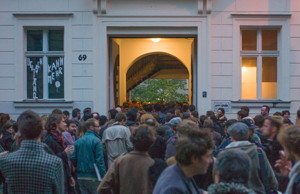Crowdfunding Buildings
- Written by: Matthew Griffin |
- Created: Friday, 11 January 2013 17:29
 Crowdfunding is a new word which repackages an old concept – financing a project
by spreading the cost amongst many different people. The same principle is used in
stock markets, taxes, and private equity funds. Internet technology has given this
“spreading” principle new traction by making it easier to reach out to individuals
sharing similar goals and values and encourage them to help finance specific projects.
Because Internet technology also reduces the cost of communicating with large groups,
it is possible to reduce the cost of investment to well below that of traditional
funding methods.
Crowdfunding is a new word which repackages an old concept – financing a project
by spreading the cost amongst many different people. The same principle is used in
stock markets, taxes, and private equity funds. Internet technology has given this
“spreading” principle new traction by making it easier to reach out to individuals
sharing similar goals and values and encourage them to help finance specific projects.
Because Internet technology also reduces the cost of communicating with large groups,
it is possible to reduce the cost of investment to well below that of traditional
funding methods.
Cultural Roots
 Wikipedia ascribes the historical
roots of crowdfunding to the music industry, and a 1997 concert tour that was financed
by a fan based Internet campaign. More recently web sites like
kickstarter have made headlines with their
groundbreaking funding systems.
Wikipedia ascribes the historical
roots of crowdfunding to the music industry, and a 1997 concert tour that was financed
by a fan based Internet campaign. More recently web sites like
kickstarter have made headlines with their
groundbreaking funding systems.
Regulatory Barriers
Because the strict regulations that govern any form of public investment offering would be too difficult and costly for cultural enterprises to fulfill, most crowdfunding web sites do not actually let people invest in a project. Instead, project initiators offer small rewards for pledging support, like a personal thank you note, free concert tickets, or an early version of the new product.
Funding urban development, however, is a completely different ball game. Unlike music, a building is a unique, tangible object not easily shared equitably with a large group. Except for the rare case of prominent public projects, any building looking for crowdfunding would have to offer either a financial return on the investment, or a part ownership of the project. This would be properly called Crowdinvesting rather than crowdfunding.
Crowdinvesting
If the funders actually profit from the venture, then it is an investment, and it falls under the same regulatory bodies that govern the likes of Goldman Sachs. In the US, the Securities and Exchange Commission (SEC) requires regulatory approval for any investment fund open to the general public. Because of the strict regulations aimed at protecting inexperienced investors from fraud, there are no American crowdinvesting sites, except ones which are only open to professionally accredited investors, like CircleUp.
This is set to change soon. The JOBS Act will ease regulation for crowdinvesting by creating an exception that allows people without accreditation to invest up to 5% of their income, or $2,000 per year. Although the JOBS Act has been approved by congress, the SEC has yet to write the rules for how this legislation will be applied. This legislation will single-handedly revolutionize crowd investment in the US.
Crowdinvesting in Germany
 German crowdfunding lags behind the USA in both scope and scale, but German crowdinvesting
is a different story. German investment regulations are more flexible and the Bundesanstalt
für Finanzdienstleistungen (BaFin), the equivalent to the SEC, allows investment funds of
up to €100,000 without their accreditation. This means that there are already a handful
of crowdinvestment companies active in Germany and the field is expanding rapidly. However,
these companies focus primarily on high tech startups, and are not well suited to
the particular needs of urban scale projects.
German crowdfunding lags behind the USA in both scope and scale, but German crowdinvesting
is a different story. German investment regulations are more flexible and the Bundesanstalt
für Finanzdienstleistungen (BaFin), the equivalent to the SEC, allows investment funds of
up to €100,000 without their accreditation. This means that there are already a handful
of crowdinvestment companies active in Germany and the field is expanding rapidly. However,
these companies focus primarily on high tech startups, and are not well suited to
the particular needs of urban scale projects.
The German web portal fuer-gruender.de has a good overview of crowdinvesting sites.
Crowdfunding for Buildings
In the USA, the first crowdfunded real estate web site, Fundrise, spent over a year wading though red tape and hundreds of thousands of dollars in legal fees to get SEC approval. They launched their web site in August 2012, and had reached 100% funding for their first project, a $325,000 shop front renovation, by November 2012. As of December 2012 they have funded three projects for a total of almost three million dollars. For their first project, the minimum investment was $100 and the average investment $2,000.
 Dan and Ben Miller, the founders of Fundrise, were particularly interested in how
this method of raising capital could allow people to actively participate in changing
their neighbourhood. Before they started Fundrise, they conducted an online survey
to find out what kind of business the community wanted in the renovated shop.
The main goal of their web site is to find a way to develop real estate that is
intimately connected to the local community. For further reading, the Atlantic
recently published a fascinating portrait of
Fundrise.
Dan and Ben Miller, the founders of Fundrise, were particularly interested in how
this method of raising capital could allow people to actively participate in changing
their neighbourhood. Before they started Fundrise, they conducted an online survey
to find out what kind of business the community wanted in the renovated shop.
The main goal of their web site is to find a way to develop real estate that is
intimately connected to the local community. For further reading, the Atlantic
recently published a fascinating portrait of
Fundrise.
In October 2012 Kapitalfreunde.de launched Germany's first crowdfunding site for property investment. Their first project was not as successful as Fundrise, but managed to raise €67,000 for a 390 sqm building in Frankfurt am Main, Germany's banking capital. The investment they offered was a loan, with no ownership rights involved. This is a small start, but the traditional forms of property funds in Germany will soon face competition from a new breed of locally oriented investment.
This new technology has unbelievable potential to change the way we relate to our cities. Crowdfunding can empower communities to help them improve their neighbourhoods in ways that we cannot yet imagine, by opening up the arcane world of property finance. Access to capital is one of the major stumbling blocks for locally grown projects. Crowdfunding won't solve all our problems, but it's a game changer.